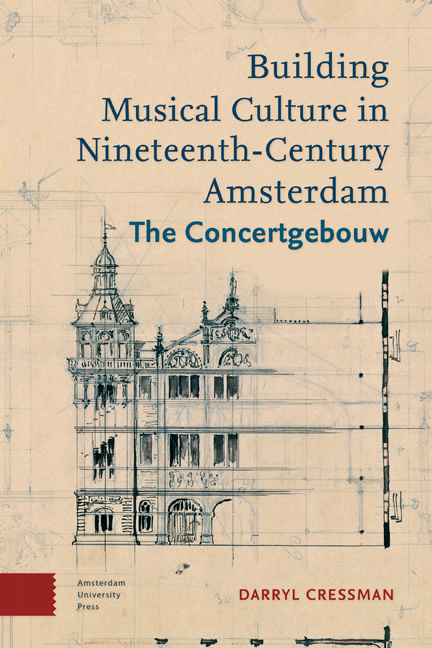Book contents
- Frontmatter
- Contents
- List of Illustrations
- Acknowledgements
- Dedication
- 1 The Concert Hall as a Medium of Musical Culture
- 2 Listening, Attentive Listening, and Musical Meaning
- 3 Patronage, Class, and Buildings for Music: Aristocratic Opera Houses and Bourgeois Concert Halls
- 4 Acoustic Architecture before Science : Designing the Sound of the Concertgebouw
- 5 Frisia Non Cantat: The Unmusicality of the Dutch
- 6 Listening to Media History
- Works Cited
- Index of Names
- Index of Subjects
4 - Acoustic Architecture before Science : Designing the Sound of the Concertgebouw
Published online by Cambridge University Press: 10 December 2020
- Frontmatter
- Contents
- List of Illustrations
- Acknowledgements
- Dedication
- 1 The Concert Hall as a Medium of Musical Culture
- 2 Listening, Attentive Listening, and Musical Meaning
- 3 Patronage, Class, and Buildings for Music: Aristocratic Opera Houses and Bourgeois Concert Halls
- 4 Acoustic Architecture before Science : Designing the Sound of the Concertgebouw
- 5 Frisia Non Cantat: The Unmusicality of the Dutch
- 6 Listening to Media History
- Works Cited
- Index of Names
- Index of Subjects
Summary
It is not my fault that acoustics and I can never come to an understanding. I gave myself great pains to master this bizarre science, but after fifteen years labour, I found myself hardly in advance of where I stood on the first day […] I had read diligently in my books, and conferred industriously with philosophers— nowhere did I find a positive rule of action to guide me; on the contrary nothing but contradictory statements.
The Science of the Sound of Music
The success of any concert hall is its sound. A beautiful building with horrible acoustics can never be redeemed. In the lead up to the opening of Montreal's La Maison Symphonique in 2011, a newspaper headline read: ‘It looks good. But how will it sound?’ The article went on to claim that ‘the promise of better acoustics is the whole raison d’être for this building’. Similarly, the motivation for Frank Gehry's Walt Disney Concert Hall in Los Angeles (opened in 2003) was the ‘dreadful acoustics’ of the Dorothy Chandler Pavilion, the home of the Los Angeles Philharmonic Orchestra since 1964. For Gehry, good acoustics would be the defining quality of his concert hall: ‘no aspect of the scheme obsessed him so much’. In the case of New York's Philharmonic Hall at Lincoln Center, which opened in 1962, New York Times music critic Harold C. Schonberg encouraged readers to think about this building for music through acoustic terms like reverberation and reverberation time, writing ‘it is upon these factors that the fate of Philharmonic Hall will really rest’. Unlike La Maison Symphonique and the Walt Disney Concert Hall, Philharmonic Hall was considered an acoustic disaster and its design was continually revised and renovated in consultation with acousticians until finally its interior was completely rebuilt and it was reopened as Avery Fischer Hall in 1976.
For the board of Het Concertgebouw NV the days leading up to opening night (11 April 1888) must have been tense. There were constant worries about money, and more importantly they had no idea how the hall would sound.
- Type
- Chapter
- Information
- Building Musical Culture in Nineteenth-Century AmsterdamThe Concertgebouw, pp. 79 - 104Publisher: Amsterdam University PressPrint publication year: 2016



